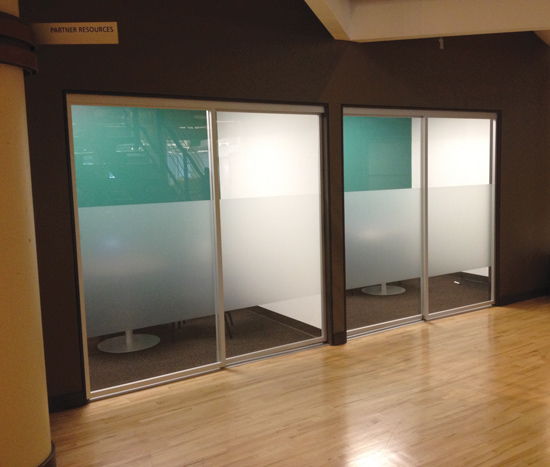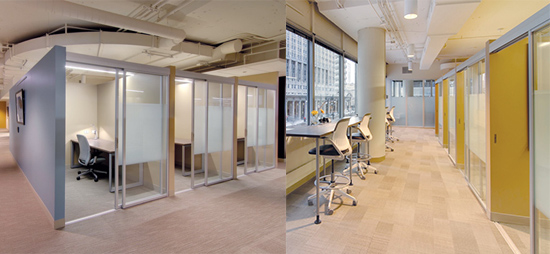The Best of Both Worlds
A Boost of Morale
On the heels of Bernard’s last statement, Linda Rodts, IIDA, LEED AP ID+C, lead interior designer, EYP Architecture & Engineering, Boston, points out that this visual connection between workers and managers enables employees to feel part of decision making and management functions, boosting morale and well-being.
“Everyone is visible. Employees at all levels can be observed by everyone in both directions of the corporate reporting structure,” adds Bernard. “When you can observe everyone around you focused on their jobs, you are more likely to focus on your work as well.”
“Interior glass enclosures allow all staff to be visually connected to their peers and leadership, encouraging the positive ‘one team’ dynamic, while discouraging any inefficiency that can develop from the disconnect of individual team members,” agrees Brett.
In a similar vein, Alan Young, design director, Gensler, Los Angeles, suggests that glass enables a greater sense of collective energy and a shared spirit of creativity. With greater knowledge about what others are engaged in, this can also encourage healthy competition.
When it’s the workers accessing the quiet spaces inside the glass partitions, “Being able to slide the panels closed to curtail foot traffic and have visual privacy, when needed, is very important, as it gives employees a measure of control over their workspaces,” states Hai-Ami.
That sense of control also extends to effective temperature controls, which can easily be designed into these enclosed spaces.
Glass systems also make a small contribution toward indoor air quality, as all it takes to clean the glass fronts is a non-chemical, mild cleaning agent, as opposed to the harsher, more toxic products required for other types of building materials.
Of course, it’s the natural light which goes the longest way toward boosting health, well-being, and productivity. Frequently spending more than a third of their day inside the office, people generally don’t have access to the daylighting and views afforded by the outdoors.
“Glass-enclosed workspaces versus traditional hardwall construction play a very important role in this respect, as studies have shown that natural light, with direct access and/or views, improves productivity and hence employee satisfaction and morale,” reports Win Roney, principal, HGA, San Jose.
“More natural light and access to views helps inspire employees to be more productive,” echoes Rodts. “Our higher education research shows us that visual connections within the workplace help people feel engaged in the work taking place in the facility and gives them a sense of ownership in the organization’s goals.
Whether it’s the well-known Heschong Mahone research—which famously established a positive correlation between daylighting and student test scores—or more recent studies continuing to validate the fact that human beings have a natural biophilic affinity to nature, daylighting is proven to enhance well-being and productivity.
For example, a fairly recent Swiss Federal Institute of Technology study found that employees working in naturally lit buildings experienced higher energy levels and fewer incidences of vision fatigue, as compared to workspaces with only electrical lighting.
As published in the American Psychological Association’s Behavioral Neuroscience journal, the Swiss study also found the test subjects in naturally lit rooms were less sleepy by the evening and showcased better cognitive performance than the test subjects inside artificially lit spaces.
Another interesting feature that rooms with sliding glass doors offer is contributing to a diversity of spaces from which employees can choose. Not only is the ability to choose between open, private, formal, and informal spaces conducive to performing tasks in a more efficient and effective manner, but once again, it affords workers their own choices.
“Flexible workspace means allowing people to work when, where, and how they desire in order to get work done,” relates Stringer. “More ‘choice’ in how work gets done has been shown by well-known professors Robert Karasek and Tores Theorell to lead to less heart disease and less chronic stress.”
“But just providing different work environments or policies is not enough. Employees have to feel they have permission to work more flexibly,” she adds. “An organizational culture that supports flexibility is essential to seeing the health and productivity benefits of a flexible space.”
Case in Point
When building out or retrofitting an office layout, it’s important to be in tune with both the organizational culture and occupants’ usage patterns and preferences.
An interesting example involves the Nashville, Tennessee-based architecture firm ESa setting out to design its own office and finding through a study of usage patterns that the designers were typically using conference rooms with 10 to 12 seats for just two to three people.
“Realizing this, we consciously chose to distribute small conference rooms—we call them enclaves—throughout our office. Rather than creating spaces with solid walls, we wanted to be sure that you could tell if a space was in use or available. The resulting use of glass fronts on these spaces achieves the open look, while providing a level of privacy needed to support the various needs of the occupants,” explains Matthew A. Manning, AIA, EDAC, senior project designer/manager, ESa, Nashville.
For another project, the Non-Profit Co-Work Space in downtown Mobile, Alabama, the goal was enabling non-profit groups to share the physical workspace, administrative staffers, and event and fundraising platforms.
“We knew that some privacy would be needed for some phone calls and meetings, and thus included glass-doored phone booths and a glass-doored conference room to accommodate the sound-dampening needed for private moments as an individual and as a group, without compromising the open loft feel of the space or significantly altering the building interior’s original character,” relates Architect Courtney Brett, RA, AIA, NCARB, Daphne, Alabama.
Shortly before the project’s construction phase, a number of the non-profit executives expressed a last-minute desire to include a few private offices in the space. “While I was initially very resistant to the inclusion of any private workspaces in an environment so intentionally collaborative, glass partitions became a reasonable compromise to support the original intent of the project, while allowing some flexible, visible transparent workspaces,” adds Brett.
Like the Non-Profit Co-Work Space, this “phone booth” trend has actually started taking off.
Starbucks was among the first to use phone booths and incorporated phone booths into its corporate offices, along with nine trial locations, where they’re currently monitoring usage by people coming in to conduct business.

Kicking off the glass phone booth trend, Starbucks has these accessible pods in its corporate offices and nine trial locations where customer usage is currently being monitored.
“Rather than sitting out in the open at a coffee table and speaking with a client or contact about sensitive topics, people can now go into a phone booth, just the right size for two to three people, to have a conversation and move deals along while enjoying their cup of coffee and a muffin,” reports Hai-Ami.
In addition, the global coworking firm WeWork, the nationally based coworking corporation Serendipity Labs, and hundreds of insurance agencies, doctor’s offices, and hotels have already incorporated these phone booths into their spaces, reports Hai-Ami.

Gaining popularity in coworking facilities such as this one, glass phone booths are a great way to make these spaces more accessible and flexible for the small business owners, entrepreneurs, and freelancers utilizing these spaces.
“Phone booths give people a place to have some privacy from foot traffic while connecting any technology they need to do their work,” she says. “The open-air work area allows for sharing of lighting, heating, and air-conditioning, further enhancing well-being and reducing costs for the building owners.”
Furthermore, the whole coworking trend has taken off as well, particularly for small business owners, entrepreneurs, and freelancers in larger urban areas.
Because coworking spaces are largely open communal spaces—70 percent open and 30 percent enclosed—which is more cost-effective and flexible model for both the provider and client, Sherry Carroll, senior project manager, HGA, San Jose, anticipates that more of these companies will continue to introduce enclosed meeting spaces with interior glazing systems—such as glass partitions—to maintain the visibility and connection, which is a big draw for these environments.
Further outlining the benefits of interior glass phone booths in coworking facilities, Boucher explains that the transparency enables people to see if the room is in use as well as identify individuals inside the rooms. And being that these booths are generally small, the glass doors work to create a sense of an enlarged visual space.
“We often recommend glass on two sides if possible, even if one is clerestory, and a square-shaped room, which is the most comfortable shape for small spaces,” she adds.
Offering some perspective on the overall coworking trend, Brett points out, “The benefits of shared or non-permanent workspaces—low overhead, balanced by distinct professionalism—are the keys to success in this marketplace,” observes Brett. “Third-place providers, such as coffee shops and coworking facilities, are capitalizing on this need, and the clever ones are employing a thoughtful approach to including open spaces and private spaces alike.”









